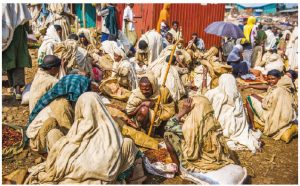
Population numbers throughout most of Africa will continue to increase severely over the next 30 years. Unless women in sub-Saharan Africa suddenly stop having more than two and sometimes as many as seven children, the gross labour force, unskilled and skilled, in almost every country will continue to grow despite existing, and alarming, unemployment rates of 40 per cent or more.
To meet the minimum income needs of its citizens, to create a more robust consumer society, to grow the tax base on which governments fund their services and welfare and to attract more and more external investment, sub-Saharan nation-states need to create jobs — the smarter, the more enduring and the more capable of contributing a beneficial multiplying boost, the better. New jobs are the key to sub-Saharan Africa’s future — to its increased prosperity, to its fuller integration into world trading systems and to winning its several internal battles against fundamentalist insurgents and other supposed revolutionaries.
Africa’s ability to create more jobs also depends on the growth of the Chinese economy. China purchases much of Africa’s petroleum, iron ore, coal, copper, cobalt, coltan, cadmium, ferrochrome, timber, tobacco and more. Without continued exports to China, most African economies would grind to a halt. The United States no longer buys much oil from Africa; its purchases of Africa’s metals are still significant for some countries, as are Europe’s imports from the sub-continent. But Chinese demand is the mainstay.

Reducing poverty in Africa depends on China, especially when Africa’s population is increasing so rapidly. Africa is the globe’s poorest continent, with a sub-Saharan African average GDP per capita in 2017 of $1,553. A full 65 per cent of sub-Saharan Africans earn less than $2 per day. Without new formal jobs, even the steady drift into the informal sector — vending from regulated stalls, roadside selling, urban hawking, auto-parking hustles, crime — cannot hope to provide most individuals aged 18 to 34 with the kinds of incomes that would enable them to feel wanted and productive, much less able to clothe and feed themselves adequately. Farming is a declining pursuit in many large countries; agricultural production cannot absorb all of Africa’s “surplus” workers. Nor are there any non-resource bonanzas on the horizon to provide succor for individuals and countries.
Using contemporary per capita GDP data, it is evident that sub-Saharan Africans subsist on incomes as low as US$244 a year (all subsequent dollar amounts in U.S. currency.) Ten countries show earnings below $1,000 per year. The people of another 13 manage somehow on less than $2,000 per year. The people of just five earn between $2,000 and $3,000 a year, bringing them to the brink of middle-income status. And nine nations may be considered middle income, with GDPs per capita between $3,000 and $5,000 annually. All the countries in sub-Saharan Africa with incomes above $5,000 — ranging upward to $28,000 — are the truly wealthy countries of the continent, a total of 12 that include the major petroleum exporters, diamond and other precious metal producers, several countries with remunerative tourist industries, and two manufacturers. Several of this wealthiest group are among Africa’s most sparsely populated; three are islands; one has an advanced infrastructure; another is the continent’s most populous. One harbours three ongoing civil conflicts. Not all, but a number of these wealthy nations are, by continental standards, among the best governed and best managed. Most are among the continent’s least corrupt entities; two, however, are rampantly corrupt.
Annual incomes between $244 and $29,000
Thus, given these snappy sketches, there are no easy generalizations to make either about Africa’s wealthiest or its poorest countries. Indeed, even some of the countries with the most abundant natural resources (such as the Democratic Republic of Congo) are still comparatively poor, while tiny places such as the Seychelles, with no mineral resources, are immensely rich by local standards. And wealth per capita also hides unequal distributions of resource profits, as in Angola and Equatorial Guinea. In both of those last countries, ruling elites are rich, but most inhabitants are poor and deprived of basic services. Ethiopia, although poor, can claim the distinction of being sub-Saharan Africa’s most equal economy. But all of these economies depend on China to continue growing.
According to World Bank figures, the average yearly earnings in the poorest African jurisdictions are war-torn South Sudan ($244), Somalia ($499) and the Central African Republic ($725). Slightly wealthier and also conflict-ridden and dictatorial is Burundi ($770), along with Liberia ($826), Eritrea ($844) and the Democratic Republic of Congo ($887) — all under $1,000. Those are the poorest of the poor. (The Western Hemisphere’s poorest nation is Haiti, with a 2017 GDP per capita of $729.)
The struggling poor in Africa, from $1,000 to $2,000 average annual GDPs per capita, include Niger ($1,016), Zimbabwe ($1,080), Malawi ($1,202), Mozambique ($1,247), Sierra Leone ($1,526), Madagascar ($1,555), the Comoros ($1,552), Togo ($1,570), Guinea-Bissau ($1,740), the Gambia ($1,714), Burkina Faso ($1,870), Uganda ($1,864), Ethiopia ($1,891) and Chad ($1,941).
Five countries comprise a group of not-yet-middle-income nations, up to $3,000: Rwanda ($2,036), mineral-rich Guinea ($2,194), Benin ($2,266), Senegal ($2,712) and Tanzania ($2,946).
Those African nations with average annual per capita GDPs between $3,000 and $5,000 may be considered middle income: labour-providing Lesotho ($3,130), Kenya ($3,285), the islands of São Tomé and Principe ($3,351) Cameroon ($3,694), Mauritania ($3,949), cocoa-producing Cote d’Ivoire ($3,953) copper-rich Zambia ($4,050), Ghana ($4,641) and the Sudan ($4,903).
Comparative incomes in North Africa are: Egypt ($2,495), Morocco ($3,007), Tunisia ($3,491); Algeria ($4,123) and Libya ($7,798). The last two are petroleum producers; the first three depend mostly on agriculture.
The wealthiest countries (more than $5,000) of sub-Saharan Africa, on a per capita basis, are topped by the tiny, sparsely populated, tourist-dependent Seychelles ($28,963); small, very corrupt, and petroleum-pumping Equatorial Guinea ($24,816), fabric and electronics assembler Mauritius ($22,278), oil- and iron-rich Gabon ($18,183), Botswana with diamonds, meat and tourism ($17,354); South Africa with gold, diamonds, coal, platinum, palladium and other precious metals ($13,497); Namibia ($10,475) with uranium, copper and diamonds; Eswatini (formerly Swaziland) with sugar, cotton and wood pulp ($8,496); Cape Verde with fish products ($6,831), Angola as Africa’s second-largest oil exporter ($6,388), giant Nigeria, Africa’s largest oil producer ($5,860) and the Republic of Congo ($5,359), which also has petroleum resources.
Another way of looking at wealth creation is to examine which countries are growing rapidly. Ethiopia, off a low base, has been growing at 10 per cent a year as a result of new, Chinese-sponsored, export-processing zones and shoe and textile manufacturing activity. Thanks to new oil discoveries, Ghana has been growing at 6 per cent. Lesotho, with labour exports to South Africa and some textile shipments to the U.S., has been growing at more than 4 per cent per annum. Growth in Burkina Faso, Senegal and Tanzania has been just under 4 per cent for several years. South Africa, however, is hardly growing at all, and in recent years has been in recession for several quarters. As a whole, sub-Saharan Africa’s economic growth rise mostly ended in 2016 and 2017, and the region as a whole grew less than one per cent in 2017. At that low overall rate, sub-Saharan Africa will not be able to keep pace with the enormous surge in its population numbers. Creating sufficient new jobs thus becomes difficult, if not impossible, at such low rates of economic increase.
Sub-Saharan Africa’s economic future depends, therefore, on continued demand from China (and Europe and North America), on improved governance and public management, on reductions in corruption and civil conflict, on winning the battle against terrorism; and — long term — on improved schooling so Africa can rely on the knowledge and skills that are now in short supply.
Robert I. Rotberg is the founding director of Harvard Kennedy School’s program in intrastate conflict, president emeritus of the World Peace Foundation and a fellow of the American Academy of Arts And Sciences. His latest book is The Corruption Cure. (Princeton, 2017)




